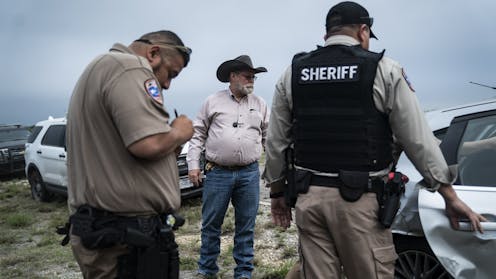Surge of ICE agreements with local police aim to increase deportations, but many police forces have found they undermine public safety
- President Donald Trump’s administration has been expanding the use of the federal 287(g) program, which allows local police to function as federal immigration officers, aiming to increase deportations and undermine public safety.
- The expansion of 287(g) agreements from 135 in 25 states in December 2024 to 628 in 40 states as of May 28, 2025, has raised concerns about the erosion of trust between local police and immigrant communities, which are crucial for preventing crime and solving criminal investigations.
- The use of 287(g) partnerships has been criticized by law enforcement professionals, including former Los Angeles Police Chief Daryl Gates and conservative police scholar George Kelling, who argue that it undermines public safety and damages community relationships.
- Research has found that mass deportation does not reduce crime rates and may even increase tensions between law enforcement and immigrant communities, with multiple studies casting doubt on the effectiveness of 287(g) partnerships in reducing crime.
- The expansion of 287(g) ignores the shift made by some big city police departments towards community policing and prioritizing relationships with diverse communities, threatening to undermine the trust and cooperation that are essential for effective public safety efforts.

During his first few months in office, President Donald Trump has been establishing a framework for deporting undocumented immigrants en masse. It’s something he has previously vowed will be “the largest deportation operation in the history of our country.”
Part of that operation includes what’s known as the federal 287(g) program. Established in 1996, it allows U.S. Immigration and Customs Enforcement, whose work is normally carried out by federal officials, to train state and local authorities to function as federal immigration officers.
Under 287(g), for example, local police officers can interview people to determine their immigration status. They can also issue immigration detainers to jail people until agents with the U.S. Immigration and Customs Enforcement take custody.
“Illegal immigration has wide-ranging consequences, including a troubling surge of dangerous drugs into our state,” T.K. Waters, sheriff of Jacksonville, Florida, said in a February 2025 statement to explain his office’s participation in 287(g). “We remain committed to partnering with President Trump’s administration and our federal counterparts to secure our borders, protect Floridians, and establish a framework for the rest of the nation to follow.”
Local police authorities across the country – from Jackson County, Texas, to Frederick County, Maryland – are participating in 287(g) for similar reasons.
Since Trump began his second term in January, ICE has increased 287(g) agreements from 135 in 25 states in December 2024 to 628 in 40 states as of May 28, 2025.
As a criminal justice scholar, I believe the surge of 287(g) agreements sets a dangerous precedent for local policing, where forging relationships and building the trust of immigrants is a proven and effective tactic in combating crime. In my view, the expansion of 287(g) will erode that trust and makes entire communities – not just immigrants – less safe.
Past federal-local cooperation
There is a long history of federal authorities collaborating with local police to enforce immigration laws.
During the Great Depression, federal officials blamed Latinos for taking American jobs, and local agencies helped them deport up to 1.8 million people to Mexico. It’s estimated that 60% of those deported were U.S. citizens.
In the early 1930s, local police participated in immigration raids in California and other states. As author Adam Goodman details in his book “The Deportation Machine,” state and local government agencies, including social workers, welfare agencies and police, acted as “de facto immigration agents.”
Trump’s mass deportation plan mirrors President Dwight D. Eisenhower’s 1954 federal immigration initiative, which resulted in 1.3 million deportations.
As author Natalia Molina notes in her book “How Race is Made in America,” local police often served as “immigration cops” in Eisenhower’s program because the federal government “did not have enough agents to cover such a large territory” as the U.S.
During his two terms, President Barack Obama deported over 5 million people and used the 287(g) program to help him do that, primarily to target jailed or recently arrived undocumented people. Obama’s use of 287(g) peaked at 76 agreements during his first term but dropped to 35 during his second term.
A Justice Department investigation launched in 2008 found the Maricopa County Sheriff’s Office in Arizona engaged in unconstitutional law enforcement actions against Latinos. The Justice Department found that the sheriff’s office engaged in a pattern of “unlawful seizures, including unjustified stops, detentions, and arrests, of Latinos in violation of the Fourth Amendment.”

Joshua Lott/Getty Images
Power of local policing
Forty states have adopted 287(g) agreements as of May 2025.
This could have effects outside of the immigration laws.
In the past 45 years, many law enforcement professionals in urban areas have highlighted the importance of forging relationships and building trust with immigrant communities. That’s because the police depend on the participation of all citizens to prevent crime and solve criminal investigations.
But police departments across the U.S. have found that 287(g) partnerships erode that trust.
In 1979, Los Angeles Police Chief Daryl Gates created Special Order 40 that prohibited local officers from enforcing immigration laws in response to community complaints alleging discrimination against Latinos. Gates issued the order “to encourage immigrants to cooperate with police and build community trust.”
Other large police departments followed. In places such as Chicago and San Francisco, they shifted focus from helping federal immigration officials to prioritizing community relationships.
William Bratton, who led six police departments, including in Boston, Los Angeles and New York, criticized 287(g) in a 2009 op-ed. He said that deputizing local officers to enforce immigration laws immediately “undermines their core public safety mission.”
Conservative police scholar George Kelling, co-author of the broken windows theory, which presumes that visible signs of disorder can lead to crime, also expressed support for local police agencies prioritizing their community relationships.
In a 1999 study, Kelling highlighted a San Diego police memo announcing its refusal to enforce federal immigration laws. The San Diego Police Department, he wrote, “thought through its values, mission, and functions and elaborated a policy that put public safety and harmony above aggressive attempts to ferret out undocumented aliens.”
During Trump’s first administration, some police chiefs echoed Bratton and Kelling. They warned that employing local officers to enforce immigration measures could spark fear and damage public safety.
Former Seattle Police Chief Kathleen O’Toole stated in 2016 that Seattle police officers were prohibited from “inquiring about a person’s immigration status.”
And former Milwaukee Police Chief Ed Flynn announced in 2016 that his department does not enforce immigration law.
He added, “It is our opinion, our strongly held belief that our responsibility is to protect the residents of our city. To protect them, they must trust us, they must be willing to report crimes, they must be willing to be witnesses.”

Robert Daemmrich Photography Inc/Corbis via Getty Images
Consequences of 287(g)
President Trump has frequently linked immigrants with higher crime rates, calling them murderers and rapists.
But multiple studies have found that undocumented people commit fewer crimes than U.S. citizens.
Although the Trump administration is expanding the use of local police in immigration enforcement, research casts doubt on using mass deportation as a crime reduction strategy.
A 2018 study on 287(g) from the libertarian Cato Institute found no evidence that ICE-led partnerships with local police decreased crime rates.
And a 2014 study on the Secure Communities Program, which calls for local police agencies to share arrestee information with federal immigration officials, found that this program has “no discernible impact” on crime in medium and large municipalities.
The Trump administration’s expansion of 287(g) ignores the shift that some big city police departments have made away from immigration enforcement in favor of community policing. And I believe it threatens to undermine the relationship between local police and the increasingly diverse communities they serve.
![]()
W. Carsten Andresen was employed in the past (2000-2003) at The Police Institute, a Rutger's University Think Tank run by George L. Kelling.
